A cable for cleaning pipes: types, how to choose the right + instructions for use
When the chemical means to eliminate the blockage in the siphon or sewage system do not work, a hard plumbing cable comes to the rescue to clean the pipes - it can be used to eliminate the problem in one go.
To work with equipment you do not need to have special qualifications, the main thing is to choose the right cable and follow the simple rules for its use. The article is devoted to the solution of these questions.
We suggest figuring out which tool is best used in a given situation, and which nozzles are suitable for cleaning sewer pipes. The instruction proposed by us will help to independently eliminate the blockage, without waiting for the plumber to arrive.
The content of the article:
Types of blockages and their causes
Before buying a cable to eliminate the sewer plug, it is necessary to determine the cause of the blockage, because in some cases mechanical and chemicals it turns out to be insufficient and the only solution to the problem is to disconnect the pipes.
All blockages are divided into three categories:
- mechanical;
- operational;
- technological.
Mechanical blockage arise most often through the fault of children who dip large toys or household items into the toilet or bathroom.
They partially block the pipes and retain fibrous structures and hair. Such congestion rarely completely blocks the drainage of water and leads to emergency situations. Eliminating the problem often ends with dismantling the pipes.
Operational blockage periodically formed in pipes with a slight slope and a large amount of greasy effluents. The inner surface of the pipes is slowly overgrown with fat, to which hair, food particles and mechanical impurities adhere.
Over time, line throughput decreases, and sewage requires flushing. It is best to eliminate operational clogging with cables.
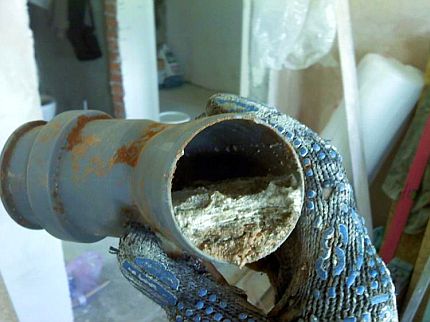
Technological reasons clogging of pipes with garbage are the result of gross design errors and installation of sewer systems. Particles and fat deposits accumulate rapidly in pipes and bends with insufficient bias.
After eliminating such a blockage, it is important to exclude its cause, otherwise after a few weeks you will have to clean the pipes again.
Each blockage has not only its own cause, but also optimal means of elimination. One of the options for cleaning pipes is the tried and tested mechanical method using plumbing cables of various designs.
Types of plumbing cables
Due to the large number of manufacturers of plumbing cables, the options for executing their cord and termination are quite diverse. Unites all devices, often only a handle for scrolling the cable along the axis. Almost all models are equipped with it.
According to the internal structure, cables are divided into the following types:
- cable;
- spring;
- spring-wound.
These cables are used for various blockages and require more detailed consideration.
Type # 1: Cable Rope
The rope view of the cable is the simplest solution for cleaning apartment sewerage. It has the appearance of a cord twisted from spirally twisted galvanized steel wires. Its thickness rarely exceeds 6 mm, and its length is usually 1.5-5 m.
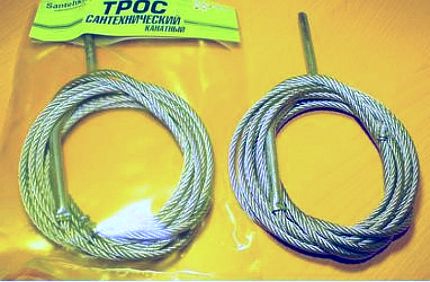
Features of a rope cable:
- Withstands high torque in the opposite direction from the curl.
- Wear resistant and durable.
- Weak breakdown force due to small diameter.
- High probability of dissolution at the end.
- It is not resilient, but has good permeability through pipes and bends of the sewage system due to its small thickness.
This cable is suitable for cleaning small operational indoor blockages. Poorly cleanses fiber and hair plugs.
Type # 2: Spring Loop Cable
The spring-wound rope is not professional and is used along with the rope type for domestic purposes.
Represents a spring wire wound around a central void. The thickness varies between 5-10 mm, and the length is 2-5 meters.
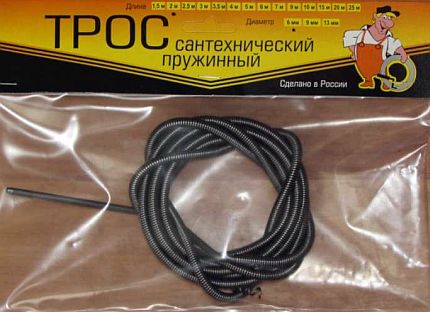
Features of the spring-wound rope:
- Withstands strong torque in the opposite direction from the curl.
- Very flexible, prone to looping in wide pipes.
- It is impossible to stretch without irreversible longitudinal deformations in the case of engagement of the end of the cable.
- Well bends sewers.
- Not equipped with nozzles.
- It is difficult to maintain: inaccessible dirt accumulates in the internal cavity.
The flexibility of the spring does not allow to create a breakdown force, but the likelihood of damage to the sewer joints is significantly reduced.
It is recommended to use a spring-wound cable to clean soft room blockages with a large number of bends of the sewer system.
Type # 3: core spring cable
The cable is a steel core made of twisted wire, which is entwined on the outside with a spring spiral. The shaft diameter can be up to 30 mm, but the standard values are 13.5 mm and 16 mm. Length can reach 60 meters.
The spring cable is used not only for domestic needs, but also for breaking through strong blockages in the house risers and even in urban sewers.
There are two main modifications to this cable:
- with a core rotating around the shell;
- with a rigidly fixed core.
Rigid core devices are similar to a wire rope type. They consist of several layers of twisted wire, each of which is wound in the opposite direction to the previous layer. The last layer is wound in the form of a spring
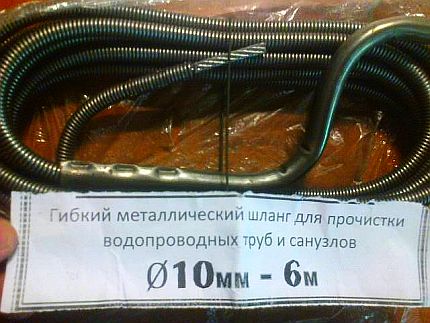
As a result, the cable is incredibly strong and resistant to torsion in any direction. At the end, there is usually a mount for the nozzle.

In a cable with a core rotating around the shell, the last layer is wound with a gap. The end of the core has a nozzle mount. The torsion handle is attached directly to the core.
This design allows the cable to be inserted into the clogged pipe over a long distance and the plug can be cleaned with a nozzle only at the exit from the outer shell.
Features of a spring cable with a core:
- withstands strong torque;
- has a high piercing ability;
- sewer deposits are not sprayed from the cable during torsion;
- not flexible, does not fit straight bends well;
- does not scratch the cleaned pipe along the entire length;
- equipped with nozzles.
A spring cable with a rotating internal shaft is often used by professional plumbers, but even at home, it also breaks the mash without problems.
Additional equipment for cables
In addition to the cable itself, there is additional equipment that facilitates the process of eliminating blockages.
The following devices belong to it:
- manual pinwheel with cable drum;
- an electric machine for twisting and winding a cable;
- nozzles;
- flexible shells.
Electrical and mechanical sewer cleaning devices facilitate the process of rolling and winding the cable. Using a drum allows you to not twist the entire dirty cable located outside and not to spray dirt on the bathroom.
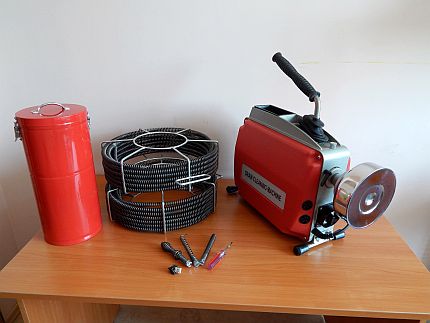
Nozzles at the end of the cable are used to increase the efficiency of eliminating blockages, depending on the type of garbage and the diameter of the pipe being cleaned. And the rubberized coating of spring models facilitates the passage through pipes and accelerates the cleaning of the product after work.
Nozzles for sewer cable
Far to every plumbing cable is equipped with a special tip for cleaning pipes from debris. But at the end of a cheap wire rod, you can independently make a “rosette” by pre-rewinding a section 5-6 cm from the edge with copper wire so that the cable does not open further.
More expensive models have a threaded tip at the end for winding special nozzles of the following types:
- In the form of a hook. Used to clean congestion with hair and fiber debris.
- Hinge nozzle. It is a widely wound spiral made of spring steel and resembles a kitchen whisk with a chopped off sharp end. It is a universal nozzle.
- Metal brush. Suitable for cleaning dense parietal deposits. Steel models scratch plastic from the inside, so it is recommended to use them only in metal pipes.
- Tick-shaped nozzle. It is used to exfoliate fatty and viscous deposits on the walls of pipes.
- Lance Punch. It is used to pass through dense deposits in highly narrowed pipes. The working edge of the nozzle may be with teeth for “biting” into the blockage at the time of rotation.
Other types of tips: bottom, "rosette", horn-shaped, screw, etc.
You need to ask for nozzles immediately in the store, because the method of attachment and thread diameter may vary. The best option would be to purchase a cable complete with "native" tips.
Which cable is better to choose?
Before acquiring a plumbing cable, you need to determine the factors that affect the choice of model.
These include:
- Maximum length from siphon to riser. Do not take a cable longer than this distance by more than 1 meter.
- Diameter of sewer pipes. The wider they are, the wider the cable should be, otherwise it may twist.
- Number of pipe turns. Most core cables are designed to clean horizontal pipes and bend poorly at right angles.
Preference when buying should be given to those models that have a handle, a tip for screwing nozzles, as well as an internal and external shaft.

Cables with mechanical and electrical torsion devices are very convenient, but not cheap, so their purchase is determined mainly by the financial capabilities of a person.
Step-by-step instructions for cleaning the sewer with a cable
Working with a plumbing cable does not require qualifications, and for a successful cleaning of the blockage, you only need to follow a number of rules, discussed in the instructions below.
Preparatory stage
The first thing to do before cleaning is:
- Inspect the cable for damage, grease the bushings on the handle.
- To put on a nozzle, if any.
- Change into clothes that you don’t mind subsequently throwing away.
- Remove nearby items that cannot be subsequently simply washed from dirt.
- Cover the floor and appliances near the place of work with oilcloth or rags.
Then it remains to pull the siphon corrugation from the socket of the pipe to be cleaned
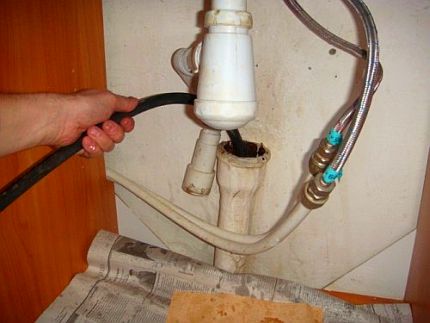
Before cleaning, it is advisable to fill the clogged riser with hot water. After the place of work is completely ready, you can proceed directly to the removal of debris from the pipe.
Clog elimination phase
During the cleaning procedure, it is necessary to unwind the cable and slowly, with forward movements, start pushing it into the pipe.
When resistance appears, it is necessary to proceed to translational-rotational movements with the handle.

Rotational movements must be carried out continuously in one direction against the direction of winding the upper layer of wires on the cable. When clogging is reached, it is necessary to increase the rotation and pushing of the tip into the pipe. Cables with a rotating inner shaft can be tensioned - this increases their rigidity and breakdown ability.
If it is difficult to scroll the cable, you need to regularly pull it out and clean it of dirt, otherwise it may twist inside the loop.
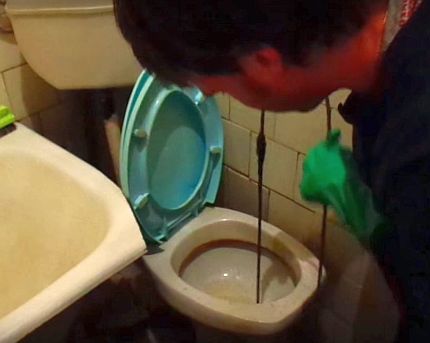
A negative consequence of excessive force when moving the cable may be damage to the tightness of the pipes at the joints with the appearance of leaks.
Rotational and rotational movement of the cable is required until the blockage is completely eliminated.

You can check the effectiveness of actions with the help of warm water, pouring it into the drain hole from a water hose or plastic bottle. If the water leaves quickly, you can try to insert a siphon drain hose into the sewer socket and feed the maximum pressure of hot water into the sink.
Evidence of elimination of the blockage will be the formation of a funnel at the drain hole.
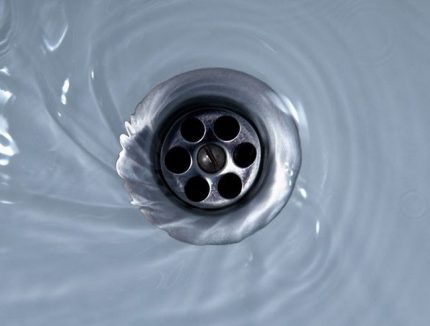
In order to prevent the formation of repeated blockages, it is necessary to establish grease trapthat filters incoming wastewater.
Final stage
After eliminating the blockage you need:
- Unscrew the siphon, clean it of dirt and reassemble.
- Insert the drain corrugated hose into the sewer pipe.
- Check the tightness of the siphon and sewage system by draining hot water into the sink with increasing pressure for 2-3 minutes.
If attempts to clear the clog with a cable were unsuccessful, then it will be necessary to dismantle the sewer and eliminate the garbage manually.
Step-by-step instructions for cleaning the toilet bowl with a cable are given in this article.
Plumbing Care
The contact of a metal cable with water is fraught with the appearance of rust and the subsequent rupture of its constituent wires. To maintain the operability of the equipment, it is necessary to observe elementary rules for its maintenance and care.
After operation, the plumbing cable must be subjected to the following procedures:
- To clear sewage from rags.
- Rinse with warm water and detergent - the best choice is dishwashing liquid. For cleaning, you can use a brush with a metal or hard plastic pile.
- Wipe dry and dry.
- Lubricate metal parts with universal engine oil. Vegetable oil does not need to be lubricated!
- Wrap with paper or place in a dry box.
Following the above instructions will extend the life of the cable, remove the unpleasant odor coming from it and keep the clothes clean when handling it.
If the blockage is not old, then you can try to eliminate it with alternative methods, for more details, see these articles:
- How to clean the toilet with a bottle: a detailed description of the process + alternative methods
- How to clean the sewer pipe at home from clogging: solutions + prevention tips
Conclusions and useful video on the topic
Video clips with practical lessons will help to clearly demonstrate the workflow of cleaning pipe clogs using a plumbing cable. They show the specifics of the use of various models of equipment and disclose an algorithm for their use.
Sink drain cleaning:
Eliminating blockage with a drill and plumbing cable:
Removing a clogged sewer riser using an electrical installation:
Eliminating the clogging of pipes in the sewage system is quite simple. To do this, you should buy the necessary cable and follow the above instructions. It is better to devote ten minutes to self-cleaning pipes from debris than to suffer for months from slowly draining water in a sink or bathtub.
If you have experience with cable clogging, please share this information with our readers. Tell us which tool and which nozzle you used, or suggest an effective tool for cleaning sewer pipes. You can leave comments on the form below.

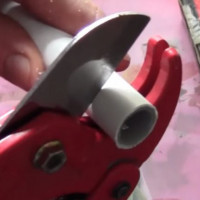 Pipe cutter for plastic pipes: types, which is better to choose and how to use it correctly
Pipe cutter for plastic pipes: types, which is better to choose and how to use it correctly  Glue for PVC pipes: an overview of the best compositions and instructions for use
Glue for PVC pipes: an overview of the best compositions and instructions for use 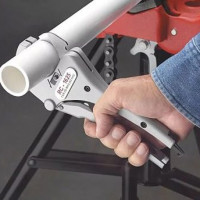 Scissors for cutting polypropylene pipes: species overview + instructions for use
Scissors for cutting polypropylene pipes: species overview + instructions for use 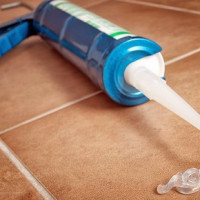 Sealant for the bathroom: types, selection tips and instructions for use
Sealant for the bathroom: types, selection tips and instructions for use 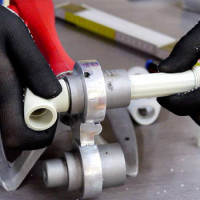 How to choose an iron for welding polypropylene pipes and how to use it correctly
How to choose an iron for welding polypropylene pipes and how to use it correctly 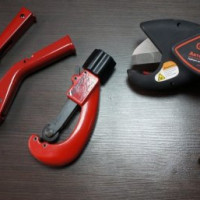 Pipe cutter for plastic pipes: choose the best model + instruction for use
Pipe cutter for plastic pipes: choose the best model + instruction for use  How much does it cost to connect gas to a private house: the price of organizing gas supply
How much does it cost to connect gas to a private house: the price of organizing gas supply  The best washing machines with dryer: model rating and customer tips
The best washing machines with dryer: model rating and customer tips  What is the color temperature of light and the nuances of choosing the temperature of the lamps to suit your needs
What is the color temperature of light and the nuances of choosing the temperature of the lamps to suit your needs  Replacement of a geyser in an apartment: replacement paperwork + basic norms and requirements
Replacement of a geyser in an apartment: replacement paperwork + basic norms and requirements
Yes, without a good cable, you don’t even have to approach pipe cleaning. We had an old cable, when the pipe became clogged, they wanted to clean it. Attempts were in vain. It was worth buying a new cable, and everything was fine. Usually I’m not cleaning alone, but with at least one assistant. So much easier for a beginner. But our problem is that no one dried the cable after cleaning and immediately threw it into the pantry. The rust went a little, though it doesn’t affect the quality of the cleansing. By the way, we have a cable rope.
I bought a cable so that: 1) it went into the drain hole of the bath without removing the protective siphon grille; 2) so that you can deal with him alone. Honestly, I didn’t think what type he was, now I looked - spring-wound. I clean them only the pipes coming from the bathtub and sink, the clogs there are small, and this is enough. And I would not be able to cope with a serious cable, it requires man's strength.
Not only physical strength, but dexterity is needed for cable cleansing. I myself broke through a blockage. My son, who at that time was 8 years old, helped a little. But, as you can understand, neither I nor he were distinguished by great physical strength. Although maybe it was just a simple blockage.
It was a matter of a sewer clogging up with me, so tightly that nothing but a cable helped. By the way, I used a machine cable, steel, with a diameter of 8 millimeters, if not more. He is tough, fucked for a long time, but in the end broke the cork. The end of the cable is simply dismantled into small wires.
Thank you, very informative. Competently written.